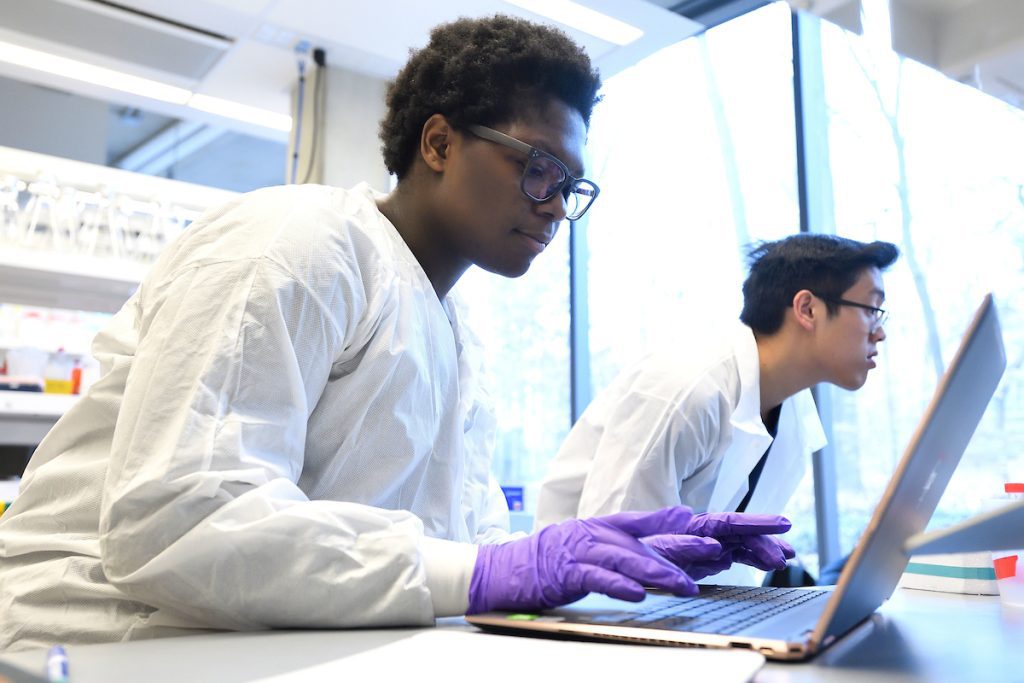Biophysics 252

A writing-enriched Biophysics lab course
In Biophysics’ Protein Engineering and Biochemistry Laboratory (PEBL), students work in groups over the course of the semester to investigate the relationship between protein structure and function. Each group induces different mutations into a common protein and measures the resulting changes to the protein’s properties. Students evaluate their individual results in relation to the results of other groups and present their findings both orally and in a written report at the end of the semester. Each semester, students work with novel variants, meaning that the results are not predetermined. There are no prerequisites for the class, which supports eight sections of up to 24 students each.
The writing assignments in PEBL were developed via collaboration between faculty in Biophysics and the University Writing Program and continue to be refined by Jaime Sorenson and Aaron Robinson, Senior Lecturers in Biophysics.
Course Design and Major Assignments
The syllabus communicates to students the purpose of writing in PEBL and the importance of writing to scientific inquiry, as well as the course structure.
Work in PEBL builds towards a final written report (Long Assignment 3, or LA3), which is scaffolded via intermediate assignments that students complete throughout the semester. This scaffolding begins with the first major writing assignment in the course, a two-page Hypothesis assignment (LA1) in which students must explain the research question they are addressing, the goal of their experiments, their expected results, and the motive and significance of the project. During the middle of the semester, students complete LA2, in which they write up methods and results for several major experiments as they complete them. LA1 and LA2 form the basis of the introduction and body of LA3.

Opportunities for Feedback and Revision
This assignment sequence means that when students approach LA3, they have already drafted and received feedback on its major components. To provide a similar opportunity for feedback on the final component of LA3—which requires students to synthesize results from multiple groups and compose conclusions—and to provide practice with a different modality of communication, students sum up their findings in an oral presentation at the end of the semester, which takes place before they submit the draft of LA3.
Requiring students to share drafts and oral presentations that receive feedback from peers and/ or instructors sends the message that revision is expected in PEBL. Detailed rubrics, which are shared with students in advance, help to ensure that feedback is consistent across sections and tailored to the learning goals of each assignment. The explicit evaluation criteria set forth in the rubrics also enable students to give targeted feedback during peer review.
As the course has evolved, so have the specifics of how feedback is given. For example, students originally received a grade and feedback on LA1 (the Hypothesis assignment) and could use the feedback to improve the text of LA3 at the end of the semester. In later iterations of the class, Jaime and Aaron switched to an initial round of instructor comments without a grade on the LA1, allowing students to revise and resubmit before receiving a grade. They report that this change increased student satisfaction with the class, improved the tenor of the feedback interactions between students and instructors, and made assigning grades easier for the instructors.
Writing to Learn in PEBL
Short, low stakes writing assignments help students engage with the content of the course and allow instructors to check for understanding before students tackle more significant projects. These low-stakes writing assignments include short-answer conceptual questions and summarizing and responding to biophysics-relevant news articles. These assignments are graded on a satisfactory/ unsatisfactory basis. To help students understand the standards for satisfactory work, instructors share examples of satisfactory and unsatisfactory submissions from previous semesters. Another example of a “write to learn” activity is the “Quick Check” questions that students complete after a lab, meant to assess their understanding of the experiments before they embark on the LA2 write-ups.
Teaching Assistants in PEBL
The biophysics graduate students who serve as teaching assistants are essential to the course’s success. TAs grade and give feedback on student writing and hold office hours. Detailed rubrics help to normalize assessment across the teaching team, but on-going discussion of how to apply the rubrics is essential. Before an assignment is graded, Jaime and Aaron select and distribute a range of student submissions to the TAs. (Since the course has been running for several semesters in its current form, this can now be done pre-submission with examples from previous semesters.) All members of the teaching team read, comment on, and apply the rubric to each submission on their own. Then, they meet to discuss their responses and develop consensus about cut-offs for each standard. Having these conversations before instructors and TAs grade the bulk of work on their own saves time and effort that would be spent re-grading and bringing feedback into alignment after the fact (as this group has learned the hard way!).
